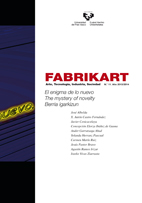Beauty and the Beast as a Language in Contemporary Art. The Beauty of Hideous: Hickey against Kant
##plugins.themes.bootstrap3.article.main##
##plugins.themes.bootstrap3.article.sidebar##
Abstract
This work propounds an approach about the new concept of beauty
—seductive and repulsive, affectionate in the morbid harmony existing between what fascinates and what repels us—which has appeared as contemporary art language during the last two decades, especially after the thesis of the North American critics Dave Hickey, the author of a controverted book: The Invisible Dragon: Four Essays on Beauty,University of Chicago Press, Chicago, 1993. He opposes Kant's theory of taste and tries to purloin this kind of subversive beauty, adapting it exclusively to the model of North American art and culture. Opposed to his, our thesis is argumentatively exposed throughout a diachronic look at occidental contemporary art and culture, from historic vanguard to the most recent one, in order to enhance that antimonic and contradictory beauty which exists in the basis of all the European art since the myth of Beauty and the Beast.

